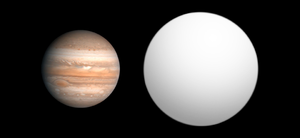- COROT-2b
-
COROT-2b Extrasolar planet List of extrasolar planets 
Size comparison of COROT-2b with Jupiter. Parent star Star COROT-2 Constellation Aquila Right ascension (α) 19h 27m 06.5s[1] Declination (δ) +1° 23′ 01.5″[1] Distance 930 ly
(290 pc)Spectral type G7V[2] Orbital elements Semimajor axis (a) 0.0281 ± 0.0005[1][3] AU Eccentricity (e) 0 (assumed)[1] Orbital period (P) 1.7429964 ± 0.0000017[1] d Inclination (i) 87.84 ± 0.10[1]° Time of transit (Tt) 2454237.53562 ± 0.00014[1] JD Physical characteristics Mass (m) 3.31 ± 0.16[1] MJ Radius (r) 1.429 ± 0.047[1] RJ Density (ρ) 1310 ± 40[1] kg m-3 Surface gravity (g) 38.2[4] m/s² Temperature (T) 1537 ± 35[1] K Discovery information Discovery date 2007-12-??,
announced 2007-12-20Discoverer(s) Corot mission Detection method Transit method Discovery site Earth's orbit Discovery status Confirmed Other designations CoRoT-Exo-2bDatabase references Extrasolar Planets
Encyclopaediadata SIMBAD data COROT-2b (formerly known as COROT-Exo-2b[5]) is the second extrasolar planet to be detected by the French-led COROT mission, which orbits the star COROT-2 at a distance of 930 light years from Earth towards the constellation Aquila. Its discovery was announced on 20 December 2007.[6] After its discovery via the transit method, its mass was confirmed via the radial velocity method.
Characteristics
 The radial velocity trend of COROT-2, caused by the presence of COROT-2 b.
The radial velocity trend of COROT-2, caused by the presence of COROT-2 b.
The planet is a large hot Jupiter, about 1.43 times the radius of Jupiter and approximately 3.3 times as massive. Its huge size is due to the intense heating from its parent star, which causes the outer layers of its atmosphere to bloat. The extremely large radius of the planet indicates that COROT-2b is really hot, estimated to be around 1500 K, even hotter than would be expected given its location close to its parent star. This fact may be a sign of tidal heating due to interactions with another planet.[7] At Jupiter-like distances its radius would roughly be the same as Jupiter.[8]
COROT-2b orbits its star approximately once every 1.7 days, and orbits the star in a prograde direction close to the star's equator.[2] Its parent star is a G-type star, a bit cooler than the Sun but more active. It is located about 800 light-years from Earth.
It takes 125 minutes to transit its star.[9]
As of August 2008, the COROT-2b spin-orbit angle (that is, the angle between the equator of the star and the plane of the planet orbit) was calculated by Bouchy et al. by mean of the Rossiter-McLaughlin effect[10] with a value of +7.2 ± 4.5 degrees.[11]
References
- ^ a b c d e f g h i j k Alonso et al (2008). "Transiting exoplanets from the CoRoT space mission. II. CoRoT-Exo-2b: a transiting planet around an active G star". Astronomy and Astrophysics 482 (3): L21–L24. Bibcode 2008A&A...482L..21A. doi:10.1051/0004-6361:200809431.
- ^ a b Bouchy; et al. (2008). "Transiting exoplanets from the CoRoT space mission. III. The spectroscopic transit of CoRoT-Exo-2b with SOPHIE and HARPS". Astronomy and Astrophysics 482 (3): L25–L28. Bibcode 2008A&A...482L..25B. doi:10.1051/0004-6361:200809433.
- ^ The paper gives the semimajor axis as 6.70 ± 0.03 times the radius of the star, which is estimated at 0.902 ± 0.018 solar radii.
- ^ Calculated using Newtonian gravity:

- ^ Schneider, J. (2009-03-10). "Change in CoRoT planets names". Exoplanets mailing list. http://listes.obs.ujf-grenoble.fr/wws/arc/exoplanets/2009-03/msg00003.html. Retrieved 2009-03-19.
- ^ "COROT surprises a year after launch". http://www.esa.int/SPECIALS/COROT/SEMF0C2MDAF_0.html. Retrieved 2007-12-21.
- ^ "CoRoT-exo-2 c?". http://oklo.org/?p=262. Retrieved 2007-12-21.
- ^ Gibor Basri; Brown (2006-08-20). "Planetesimals to Brown Dwarfs: What is a Planet?". Ann.Rev.Earth Planet.Sci. 34 (2006) 193-216 34: 193–216. arXiv:astro-ph/0608417. Bibcode 2006AREPS..34..193B. doi:10.1146/annurev.earth.34.031405.125058.
- ^ "Predicted Transit Epochs: CoRoTExo2 b". TransitSearch (Oklo Corporation). http://207.111.201.70/transitsearch/dynamiccontent/CoRoTExo2b.transits.txt. Retrieved 2009-07-15.
- ^ Joshua N. Winn (2008). "Measuring accurate transit parameters". arXiv:0807.4929 [astro-ph]. doi:10.1017/S174392130802629X.
- ^ Bouchy et al.; Queloz, D.; Deleuil, M.; Loeillet, B.; Hatzes, A. P.; Aigrain, S.; Alonso, R.; Auvergne, M. et al. (2008). "Transiting exoplanets from the CoRoT space mission. III. The spectroscopic transit of CoRoT-Exo-2b with SOPHIE and HARPS". Astronomy and Astrophysics 482 (3): L25. Bibcode 2008A&A...482L..25B. doi:10.1051/0004-6361:200809433.
External links
 Media related to COROT-2b at Wikimedia Commons
Media related to COROT-2b at Wikimedia CommonsCoordinates:
 19h 27m 06.5s, +01° 23′ 01.5″
19h 27m 06.5s, +01° 23′ 01.5″
This extrasolar planet related article is a stub. You can help Wikipedia by expanding it.
